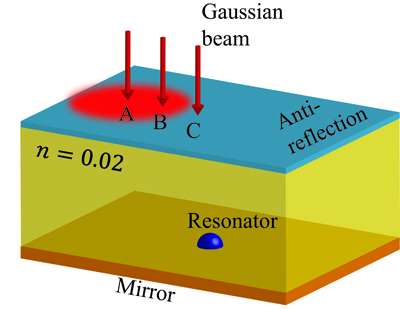A diagram shows an optical nanoresonator embedded within a slab of low-index material to test its performance.
University of Wisconsin-Madison engineers have created a nanoscale device that can emit light as powerfully as an object 10,000 times its size. It's an advance that could have huge implications for a variety of imaging and energy applications.
In a paper published July 10, 2015 in the journal Physical Review Letters, Zongfu Yu, an assistant professor of electrical and computer engineering at UW-Madison, and his collaborators describe nanoscale device that that drastically outpaces previous technology in its ability to scatter light. They showed how a single nanoresonator can manipulate light to cast a very large "reflection." The nanoresonator's capacity to absorb and emit light energy is such that it can make itself—and, in applications, other very small things—appear 10,000 times as large as its physical size.
"Making an object look much 10,000 times larger than its physical size has lots of implications in technologies related to light," Yu says.
The researchers realized the advance through materials innovation and a keen understanding of the physics of light. Much like sound, light can resonate, amplifying itself as the surrounding environment manipulates the physical properties of its wave energy. The researchers took advantage of this by creating an artificial material in which the wavelength of light is much larger than in a vacuum, which allows light waves to resonate more powerfully.
The device condenses light to a size smaller than its wavelength—meaning it can gather a lot of light energy—and then scatters the light over a very large area—meaning its output can be harnessed for imaging applications that make microscopic particles appear huge.
"The device makes an object super-visible by enlarging its optical appearance with this super-strong scattering effect," Zhou says.
Much as a very thin string on a guitar can absorb a large amount of acoustic energy from its surroundings and begin to vibrate in sympathy, this one very small optical device can receive light energy from all around and yield a surprisingly strong output. In imaging, this presents clear advantages over conventional lenses, whose light-gathering capacity is limited by direction and size.
"We are developing photodetectors based on this technology, and, for example, it could be helpful for photographers wanting to shoot better quality pictures in weak light conditions," Yu says.
Given the nanoresonator's capacity to absorb large amounts of light energy, the technology also has potential in applications that harvest the sun's energy with high efficiency. In addition, Yu envisions simply letting the resonator emit that energy in the form of infrared light toward the sky, which is very cold. Because the nanoresonator has a large optical cross-section—that is, an ability to emit light that dramatically exceeds its physical size—it can shed a lot of heat energy, making for a passive cooling system.
"This research opens up a new way to manipulate the flow of light, and could enable new technologies in light sensing and solar energy conversion," Yu says.
More information: "Extraordinarily Large Optical Cross Section for Localized Single Nanoresonator." Phys. Rev. Lett. 115, 023903 – Published 10 July 2015. journals.aps.org/prl/abstract/ … ysRevLett.115.023903
Journal information: Physical Review Letters
Provided by University of Wisconsin-Madison
























